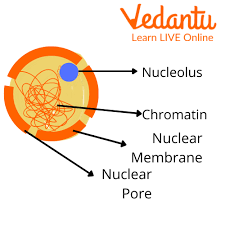What is the Nucleolus?
The nucleolus is a prominent, rounded structure found inside the nucleus of eukaryotic cells. It is mainly composed of RNA and proteins. In most cells, there may be one or more nucleoli (plural of nucleolus). Its primary function is to form the subunits that assemble into ribosomes, which are essential for protein synthesis. The nucleolus also plays a role in modifying transfer RNA (tRNA) and in sensing cellular stress.
Unlike the nuclear envelope, which is a membrane-bound structure around the nucleus, the nucleolus does not have a membrane enclosing it. Hence, even though it appears dense under a microscope, it remains an organised region within the nucleus rather than a separate, membrane-bound organelle.
Did you know? The nucleolus makes up about 25% of the nuclear volume in many cell types.
Structure of the Nucleolus
Under an electron microscope, the nucleolus shows four major components:

Fibrillar Centres (FC): These are regions where ribosomal RNA (rRNA) genes are located. They are also sites where the initial steps of rRNA synthesis can occur.
Dense Fibrillar Components (DFC): Newly synthesised rRNA is found here. These rRNA molecules start to pair with ribosomal proteins in the DFC.
Granular Components (GC): These regions contain nearly completed ribosomal subunits. Before the final formation of ribosomes, rRNA binds to ribosomal proteins in the GC.
Nucleolar Vacuoles: Seen mostly in plant cells, these vacuole-like structures can vary in number and may help store materials within the nucleolus.
In certain plant species, the nucleolus has a higher concentration of iron compared to that in animal cells.
Nucleolus Function
The nucleolus function is of great importance in cell biology. It is often referred to as the control centre within the nucleus for ribosome production. Some key functions include:
Ribosome Subunit Assembly: The nucleolus produces and assembles the subunits (large and small) that combine to form ribosomes, which carry out protein synthesis.
rRNA Synthesis and Processing: It is the primary site for rRNA gene transcription and the modification of rRNA molecules.
tRNA Modification: The nucleolus also takes part in the processing and maturation of transfer RNAs.
Cell Stress Response: Changes in the nucleolus may indicate cellular stress or damage, which helps the cell respond to various conditions.
Difference between Nucleus and Nucleolus
It is common for students to wonder about nucleoli vs nucleus. Although both lie at the heart of the cell, they differ in several aspects:
Note: In prokaryotic cells (such as bacteria), there is a region called the nucleoid, which contains the genetic material, but there is no true nucleus or nucleolus.
Chromatin and Its Function
Inside the nucleus, DNA is packaged with proteins to form chromatin. Chromatin function is to efficiently organise and control DNA activities such as replication, transcription, and gene regulation. Chromatin can be either tightly coiled (heterochromatin) or loosely coiled (euchromatin), influencing how genes are expressed.
Additional Insights
The membrane surrounding the cell (often referred to as the plasma membrane or cell membrane) is distinct from the nuclear envelope. The nuclear envelope encloses the nucleus, whereas the cell membrane encloses the entire cell.
In plants, high iron content in the nucleolus may be linked to specific metabolic activities and storage processes that differ from those in animal cells.
Quick Quiz (with Answers)
Which cell structure houses the nucleolus?
Answer: The nucleus of a eukaryotic cell.
What is the main function of the nucleolus?
Answer: It is the site of ribosomal subunit production and assembly.
True or False: The nucleolus is surrounded by the nuclear envelope.
Answer: False, it has no membrane.
Name the primary molecule synthesised in the nucleolus that is crucial for ribosome formation.
Answer: rRNA (ribosomal RNA).
The nucleolus is a vital, non-membrane-bound region within the nucleus of eukaryotic cells. It is responsible for ribosome subunit assembly, rRNA transcription, and the initial steps of tRNA modification. Its ultrastructure includes fibrillar centres, dense fibrillar components, granular components, and (in plants) nucleolar vacuoles. Its function is closely tied to protein production, making it crucial for the cell’s overall metabolism and stress response. Understanding the nucleolus also involves knowing how it differs from the nucleus, especially regarding DNA content and membrane boundaries.
Related Topics


FAQs on Nucleolus in Eukaryotic Cells
1. Is the nucleolus present in all eukaryotic cells?
Yes, most eukaryotic cells have at least one nucleolus, but its appearance and number can vary depending on the cell type and stage of the cell cycle.
2. Does the nucleolus disappear during cell division?
The nucleolus disassembles during mitosis and reassembles in the daughter nuclei once cell division is nearly complete.
3. How is the nucleolus different from the nucleoid?
The nucleoid is found in prokaryotic cells and contains genetic material without a surrounding membrane. The nucleolus, on the other hand, is an organised region within the nucleus of eukaryotic cells and specialises in ribosome assembly.
4. Why is the nucleolus called the ‘site of ribosome biogenesis’?
It is called so because it is directly involved in synthesising and processing rRNA and assembling ribosomal proteins to form ribosomal subunits, which later combine to make complete ribosomes.
5. Does the nucleolus help in any other cellular process besides ribosome production?
Along with ribosome biogenesis, the nucleolus helps process tRNA, sense cellular stress, and regulate certain aspects of the cell cycle.










